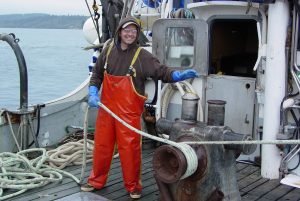The Dangers of Commercial Fishing Winches
 Within Alaska’s commercial fishing industry, deck machinery has emerged as a leading source of serious injuries, with winches being a major culprit. In a study prepared by the U.S. Centers for Disease Control and Prevention and published in the Journal of Agromedicine, Volume 28, 2023 – Issue 3, injury data from the past 20 years was analyzed and used to highlight the critical need to develop targeted safety measures.
Within Alaska’s commercial fishing industry, deck machinery has emerged as a leading source of serious injuries, with winches being a major culprit. In a study prepared by the U.S. Centers for Disease Control and Prevention and published in the Journal of Agromedicine, Volume 28, 2023 – Issue 3, injury data from the past 20 years was analyzed and used to highlight the critical need to develop targeted safety measures.
The study reviewed injury claims submitted to the Alaska Fisherman’s Fund (AFF) between January 1, 2000, and November 1, 2020. Researchers identified 125 traumatic injuries caused by commercial fishing winches, revealing alarming patterns of injury and highlighting the need for practical solutions.
The vast majority of winch-related injuries occurred among male fishermen, who accounted for 94% of the cases. A significant proportion (54%) were under the age of 30, emphasizing the vulnerability of younger, less experienced workers. Over 80% of the injuries took place in Alaska’s salmon fisheries, with specific risks depending on the type of gear in use.
Vessels equipped with purse seine gear were the most dangerous, found to be responsible for 40% of the injuries studied. Drift gillnet gear caused 30% of incidents and set gillnet operations were linked to 12% of injuries.
Most winch-related accidents involved a body part being caught in or compressed by the winch or associated cables. The most frequently injured areas were upper extremities—particularly fingers (50% of cases) and hands or wrists (22%). The severity of injuries ranged widely, from sprains and lacerations to more severe outcomes like finger or hand crush injuries, amputations, skull fractures, spinal fractures, and even chest trauma. The most common types of injuries included fractures, amputations, lacerations, and contusions.
Anchor Winches Pose the Greatest Threat
The study found that over half of the injuries (51%) were caused by anchor winches, followed by deck winches (32%) and trailer winches (9%). These findings point to the urgent need for better safety measures, particularly focusing on anchor winches, which accounted for the greatest number of injuries studied.
The study underlines the need for practical solutions to prevent winch-related injuries. Engineering interventions such as emergency stop devices or mechanical safeguards tailored to each winch type could be lifesaving. Additionally, administrative controls like task-specific training—especially for younger or less experienced crew members—are vital for reducing risks.
Most accidents at sea are preventable with proper safety procedures. After an injury occurs, it is important to begin an early investigation into the facts of the maritime accident. For more information, see What to Do If You Are Injured at Sea. The employer and vessel owner should be contacted and advised to preserve all evidence relevant to the accident. Faulty equipment and unsafe conditions should not be altered until a legal team has had an opportunity to inspect the accident scene.
Stacey and Jacobsen, PLLC is known for taking on the toughest cases. They understand winch related injuries and how they impact their client’s lives, their livelihood, and their concerns about the future. They are dedicated to getting their clients fair compensation. If you or a loved one has sustained an injury while at sea, call for a no-cost legal consultation at 877.332.5529. Put an experienced team of maritime lawyers to work protecting your rights.
 Maritime Injury Law Blog
Maritime Injury Law Blog

